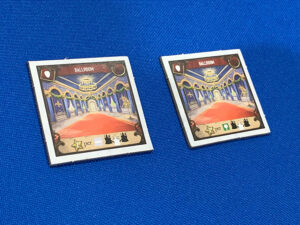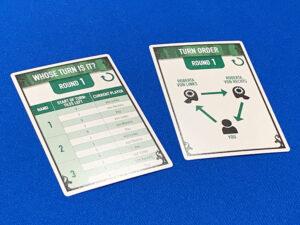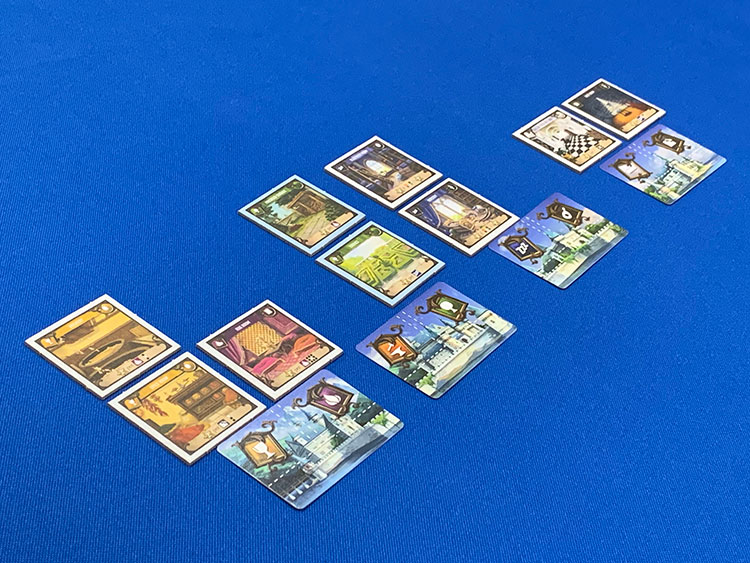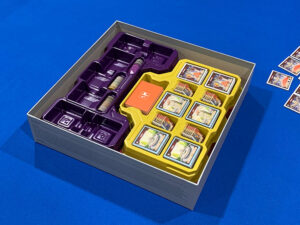 This reviewer is firmly in the camp that 90% of the time, expansions are a good thing. Even with the risks of unbalancing a game or taking a game in a new, maybe undesirable direction, on the whole, an expansion to a favorite game just gives players more of everything. However, in today’s climate of expansion planning, another thing that expansions are tasked with is expanding the scope of play options with solo and/or cooperative modes.
This reviewer is firmly in the camp that 90% of the time, expansions are a good thing. Even with the risks of unbalancing a game or taking a game in a new, maybe undesirable direction, on the whole, an expansion to a favorite game just gives players more of everything. However, in today’s climate of expansion planning, another thing that expansions are tasked with is expanding the scope of play options with solo and/or cooperative modes.
So, it comes as no surprise that Stonemaier Games would publish an expansion for Between Two Castles that includes not one but two solo modes as well as introducing new tiles and an additional play mode. This undoubtedly is aimed at selling well in a gaming era where smaller (and of course solo) groups are more common. If readers like what they see so far, continue on to see if the expansion matches expectations.
Expansion Overview:
There are three main areas where Secrets and Soirees expands Between Two Castles: additional rooms and bonus cards, solo modes, and alternative play modes.
Additional Rooms/Cards
As one of the main draws for a game of this type, players who love to dig into the puzzly nature of placing rooms are looking for even more puzzle pieces. For Secrets and Soirees, two new room types make their appearance: Activity Rooms and Secret Rooms.

Activity Rooms score up to four points if they are bordered on the top, bottom, left and right, but if any of the surrounding eight rooms match a certain type of room, the Activity Room in question only scores one point. The favorable or unfavorable position scoring is very challenging in a game like this, and the type of scoring allows for a good amount of points if the activity rooms come one after another.
Secret Rooms, on the other hand, have an arrow on the tile and copy the room type and effects of the existing room it points at. This helps players reach the 3 and 5 room type bonus. The other possibility is that Secret Room effects can be chained by pointing one Secret Room at another and another so that a high scoring tile can be duplicated.
In addition to the above, new bonus cards for the Utility Rooms are included which add scoring options for the new rooms and expand scoring options for some additional strategies.

Solo Modes
The core game of Between Two Castles didn’t have an official solo mode, and now Secrets and Soirees comes to the rescue with two different modes: a dual automa mode and what is affectionately called the “Introvert Variant” using a single automa. In brief, the first solo mode utilizes two automa players. The AI players gather a selection of tiles for their shared “castle” (really just a collection of tiles). Additionally, each automa player is actively building a castle with the human player, but for those castles, the tile chosen by the automa follows the rules on their card and the human player makes all the placement decisions.
The Introvert Variant changes this up by having the human player only build one castle while the automa collects tiles. This is a simpler variant because the human player does not need to manage multiple castles. However, the AI is not actually building a castle and so the player is not considered an automa but merely a calculated point value against which the human is competing.
Alternative Play Modes
“The Mad King’s Demand” is a new play mode that eliminates the cooperative castle building and instead forces each player to incorporate a tile selected by their neighbor into their own personal castle. This new play mode has the advantage that it scales down to a two player game practically unchanged. On the downside, this also eliminates the “Between Two…” concept originated by the game’s original mashup concept combining Between Two Cities and Castles of Mad King Ludwig.

Game Experience with the Expansion:
Board Game Quest’s review system for expansions scales from “pass” to “optional” to “buy”. Now, for this reviewer, of the three offerings in the expansion, one is a pass, another is optional, and the last one is a buy.
New Tiles: One thing not mentioned in the Additional Rooms section above is that the expansion also includes components for an 8th player. Far be it from this reviewer to judge a game group’s attendance, but if you’re the 1 out of 100 game groups big enough to play the core game at max player count consistently, then maybe this is an immediate purchase. It just seems like a really specific option to add and only necessary if possibly 4 couples are playing the game together.

The new room concepts, however, are solid. If players might think that Secret Rooms are a fluffy concept to add that doesn’t require a lot of planning by the game designer, they should know that the ability to double an adjacent room is incredibly useful and will provide a significant reward in points when chosen well. For these tiles, Secrets and Soirees is a “buy”.
Solo Modes: An informal poll of the Board Game Quest writers showed that about 50% of writers would take notice of solo modes and two were enthusiastically in support of solo game modes. As such, solo gaming is still something that is situational. It’s great for those who prefer it or want the option, but for many others, it’s just not needed. For this reviewer, solo modes are generally inferior and less exciting. In this case, however, the Introvert Variant plays fast enough and requires a minimal amount of management to get the feel of Between Two Castles which is preferable. The fact that customers need to purchase the entire expansion just to get the needed automa cards is the real question. As such, a purchase here is “optional” based on what a buyer wants.
Alternative Play Modes: Since the rules for new play modes require no new tiles or product content, this is a “pass”. Just go look up the rules for these online. This is also a big miss given the fact that there is no working cooperatively anymore.
Final Thoughts:
Between Two Castles of Mad King Ludwig is a difficult game to plan an expansion for. The original game was tight and felt very complete. While the absence of a solo mode was something notable, it also wasn’t a game design that felt like it needed one. The cooperative nature of the game really makes solitaire just feel like a tile puzzle. That’s fine, but the expansion content apart from the solo mode isn’t enough to strongly recommend a purchase here. If you’re a fan of solo modes, this is a “buy” recommendation. For everyone else, including this reviewer, it’s an optional one.
 Hits:
Hits:
• New room types and 8th player components
• Two solo play modes
• Interesting new strategies with new room types
Misses:
• New play mode is non-cooperative
• Lots of game management with one solo mode






















